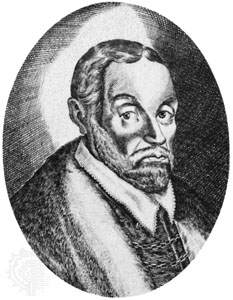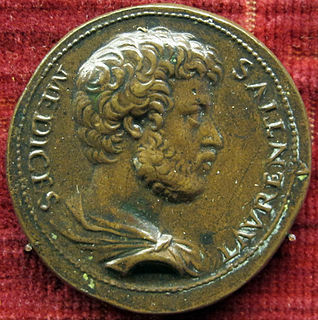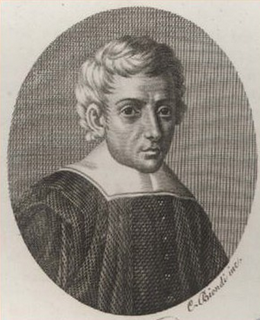 W
WAndrea Matteo Acquaviva, 8th Duke of Atri (1456–1528) was an Italian nobleman and condottiero from the Kingdom of Naples. Born in Conversano, Puglia, he was the second son of Duke Giulio Antonio Acquaviva and his wife Caterina Orsini del Balzo. She was a first cousin of Queen Isabella, the wife of King Ferrante of Naples.
 W
WGirolamo Aleandro, the younger was a very distinguished Italian scholar. His grand-uncle Girolamo Aleandro, the elder (1480–1542) is better known and was the first cardinal appointed in pectore.
 W
WCesare Baronio was an Italian cardinal and ecclesiastical historian of the Roman Catholic Church. His best-known works are his Annales Ecclesiastici, which appeared in 12 folio volumes (1588–1607). Pope Benedict XIV conferred upon him the title of Venerable.
 W
WGiambattista Basile was an Italian poet, courtier, and fairy tale collector. His collections include the oldest recorded forms of many well-known European fairy tales.
 W
WAlessandro Benedetti (1450?–1512) was born in Parma, traveled and worked extensively in Greece and Crete, and worked as surgeon general of the Venetian army. His “Anatomice, or The History of the Human Body” is a descriptive anatomy in the style of Mundinus. It concludes with a final chapter on the praise of dissection. He expresses the need for a clinical examination rather than uncritical trust in the authorities “since in it we see the truth and contemplate its revelations as the works of nature lie under our eyes… but those who trust only the monuments of literature… are often deceived and entrust opinion rather than truth to their minds.” He later describes a postmortem examination of a woman who had died of syphilis and the disease’s effects on her bones. Benedetti critiqued those anatomists who trusted in the authorities more than their own experience: “Aristotle has had so much authority for so many centuries that even those things which [physicians] have not seen they will affirm to exist, even without experiment.” Benedetti valued personal observation over blind trust in the authorities and even, shockingly for the time, corrected Aristotle. “Aristotle believes that the nerves first arise from the heart… but almost all of them are perceived to originate in large part from the brain….” Medieval scholars preferred to trust the authorities over their own observations, while this new generation of anatomists increasingly valued the experience over theory.
 W
WGiambattista (Gianbattista) Benedetti was an Italian mathematician from Venice who was also interested in physics, mechanics, the construction of sundials, and the science of music.
 W
WAngelo Beolco, better known by the nickname Ruzzante or Ruzante, was an Venetian actor and playwright. He is famous for his rustic comedies, written mostly in the Paduan dialect of the Venetian language, featuring a peasant called "Ruzzante". Those plays paint a vivid picture of Paduan country life in the 16th century.
 W
WTommaso Campanella, baptized Giovanni Domenico Campanella, was an Italian Dominican friar, philosopher, theologian, astrologer, and poet.
 W
WBaldassare Castiglione, count of Casatico, was an Italian courtier, diplomat, soldier and a prominent Renaissance author, who is probably most famous for his authorship of Il Cortegiano or The Book of the Courtier. The work was an example of a courtesy book, dealing with questions of the etiquette and morality of the courtier, and was very influential in 16th-century European court circles.
 W
WSabba da Castiglione, fra' Sabba da Castiglione or Saba da Castiglione was an Italian Renaissance humanist, writer and member of the Knights Hospitaller.
 W
WMaddalena Casulana was an Italian composer, lutenist and singer of the late Renaissance. She is the first female composer to have had a whole book of her music printed and published in the history of western music.
 W
WFrancesco Colonna was an Italian Dominican priest and monk who was credited with the authorship of the Hypnerotomachia Poliphili by an acrostic formed by initial letters of the text.
 W
WLuigi Da Porto was an Italian writer and storiographer, better known as the author of the novel Novella novamente ritrovata with the story of Romeo and Juliet, later reprised by William Shakespeare for his famous drama.
 W
WBernardo Davanzati was an Italian agronomist, economist and translator.
 W
WTiberio Deciani or Decianus (1509–1582) was an Italian jurist working in the tradition of Renaissance humanism.
 W
WPietro Delfino or Delfin, O.S.B. Cam., was an Italian Camaldolese monk, patristic scholar, theologian, abbot, and Superior General of his religious Order.
 W
WCamilla Erculiani was an Italian apothecary, writer, natural philosopher and women's advocate during the early modern period. This "self-described pharmacist" published a book, in the form of letter-essays, about her views on topics of science and natural philosophy. Erculiani's Lettre di philosophia naturale or Letters on Natural Philosophy was published in 1584. Due to some of the unconventional theories presented in her work, she was put on trial by the Roman Inquisition on charges of suspected heresy- for the "blurring of boundaries between natural philosophy and theology." Although the trial records are lost, it is speculated that Erculiani was likely pardoned.
 W
WGabriele Faerno, also known by his Latin name of Faernus Cremonensis, was born in Cremona about 1510 and died in Rome on November 17, 1561. He was a scrupulous scholar and an elegant Latin poet who is best known now for his collection of Aesop's Fables in Latin verse.
 W
WAntonio de Ferraris, also known by his epithet Galateo, was an Italian scholar of Greek ethnicity, academic, doctor and humanist.
 W
WFrancesco di Giorgio Martini (1439–1501) was an Italian architect, engineer, painter, sculptor, and writer. As a painter, he belonged to the Sienese School. He was considered a visionary architectural theorist—in Nikolaus Pevsner's terms: "one of the most interesting later Quattrocento architects". As a military engineer, he executed architectural designs and sculptural projects and built almost seventy fortifications for the Federico da Montefeltro, Count of Urbino, building city walls and early examples of star-shaped fortifications.
 W
WNiccolò Franco was a poet and literato executed for libel.
 W
WGalileo di Vincenzo Bonaiuti de' Galilei was an Italian astronomer, physicist and engineer, sometimes described as a polymath, from Pisa. Galileo has been called the "father of observational astronomy", the "father of modern physics", the "father of the scientific method", and the "father of modern science".
 W
WVeronica Gambara was an Italian poet, stateswoman and political leader. She was the ruler of the County of Corregio from 1518 until 1550.
 W
WLuca Gaurico was an Italian astrologer, astronomer, astrological data collector and mathematician. He was born to a poor family in the Kingdom of Naples, and studied judicial astrology, a subject he defended in his Oratio de Inventoribus et Astrologiae Laudibus (1508). Judicial astrology concerned the fate of man as influenced by the stars. His most famous work is the Tractatus Astrologicus.
 W
WThe Ragione di adoprar sicuramente l'Arme, si da offesa come da difesa was a famous treatise on fencing published by Giacomo di Grassi in 1570. The text was later translated into English and published again in 1594, as Di Grassi, His True Arte of Defence. The translation of Di Grassi was one of the three premiere fencing texts known from Elizabethan England.
 W
WGiuliano Ughi della Cavallina, or Giuliano della Cavallina, was a sixteenth-century Franciscan friar and writer. He spent his youth in his native village, La Cavallina, today a hamlet of some 2,500 inhabitants in the comune (municipality) of Barberino di Mugello, in the Province of Florence in the Italian region Tuscany, located about 25 km north of Florence. The hamlet today has a square named after its famous son: Piazza fra Giuliano Ughi, 50031 Cavallina, Italy
 W
WGiovanni Battista Guarini was an Italian poet, dramatist, and diplomat.
 W
WNiccolò di Bernardo dei Machiavelli was an Italian Renaissance diplomat, philosopher and writer, best known for The Prince, written in 1513. He has often been called the father of modern political philosophy and political science.
 W
WCarlo Maggi was a Venetian citizen and traveller. During 1568–1573, he visited much of the Near East, then under Ottoman control, including the city of Jerusalem, where he was made a Knight of the Order of the Holy Sepulchre. He was captured by the Turks during the siege of the city of Nicosia in the Cyprus War of 1570-1571, being able to free himself and to get back to Venice only after the Battle of Lepanto in 1572.
 W
WFrancesco Maurolico was a mathematician and astronomer from Sicily. He made contributions to the fields of geometry, optics, conics, mechanics, music, and astronomy. He edited the works of classical authors including Archimedes, Apollonius, Autolycus, Theodosius and Serenus. He also composed his own unique treatises on mathematics and mathematical science.
 W
WLorenzino de' Medici, also known as Lorenzaccio, was an Italian politician, writer and dramatist, and a member of the Medici family. He became famous for the assassination of his cousin, Alessandro de' Medici, Duke of Florence in 1537. He was in turn murdered in 1548 in retaliation for his deed.
 W
WOlimpia Fulvia Morata was an Italian classical scholar.
 W
WFra Luca Bartolomeo de Pacioli was an Italian mathematician, Franciscan friar, collaborator with Leonardo da Vinci, and an early contributor to the field now known as accounting. He is referred to as "The Father of Accounting and Bookkeeping" in Europe and he was the second person to publish a work on the double-entry system of book-keeping on the continent. He was also called Luca di Borgo after his birthplace, Borgo Sansepolcro, Tuscany.
 W
WSimone Porzio (1496—1554) was an Italian philosopher, born and died in Naples.
 W
WMatteo Ricci, was an Italian Jesuit priest and one of the founding figures of the Jesuit China missions. He created the Kunyu Wanguo Quantu, a 1602 map of the world written in Chinese characters. He is considered a Servant of God by the Catholic Church.
 W
WLionardo Salviati (1539-1589) was a leading Italian philologist of the sixteenth century. He came from an illustrious Florentine family closely linked with the Medici. Salviati became consul of the Florentine Academy in 1566, and played a key role in the founding of the Accademia della Crusca, with its project of creating a dictionary, which was completed after his death.
 W
WJacob Mantino ben Samuel was a Jewish scholar and Italian physician, known also as Mantinus.
 W
WJulius Caesar Scaliger, or Giulio Cesare della Scala, was an Italian scholar and physician, who spent a major part of his career in France. He employed the techniques and discoveries of Renaissance humanism to defend Aristotelianism against the New Learning. In spite of his contentious disposition, his contemporary reputation was high. Jacques Auguste de Thou claimed that none of the ancients could be placed above him and that he had no equal in his own time.
 W
WFausto Paolo Sozzini, also known as Faustus Socinus, was an Italian theologian and founder of the school of Christian thought known as Socinianism and the main theologian of the Minor Reformed Church of Poland.
 W
WTorquato Tasso was an Italian poet of the 16th century, best known for his poem Gerusalemme liberata, in which he depicts a highly imaginative version of the combats between Christians and Muslims at the end of the First Crusade, during the Siege of Jerusalem. Tasso suffered from mental illness and died a few days before he was due to be crowned on the Capitoline Hill as the king of poets by the Pope. His work was widely translated and adapted, and until the beginning of the 20th century, he remained one of the most widely read poets in Europe.
Laura Terracina was an Italian poet from Naples during the Renaissance. She was the most published Italian poet of the sixteenth century.
 W
WAlessandro Trentacinque, was a jurist, writer and patrician from L'Aquila, Italy. The Trentacinque family was also present in Lucoli. Alessandro Trentacinque was mayor of L'Aquila around 1583, carried the noble title of Camerlengo (Chamberlain) and was buried in the Sant'Agostino church in L'Aquila.
 W
WAngelo da Vallombrosa or Angelus Anachorita Vallombrosa (1455–1530) was an Italian jurist and abbot.
 W
WGiorgio Vasari was an Italian painter, architect, writer, and historian, best known for his Lives of the Most Excellent Painters, Sculptors, and Architects, considered the ideological foundation of art-historical writing. He was also the first to use the term "Renaissance" in print.
 W
WPiero Vettori was an Italian writer, philologist and humanist.
 W
WGiovanni Battista Zanchi was an Italian engineer and author.